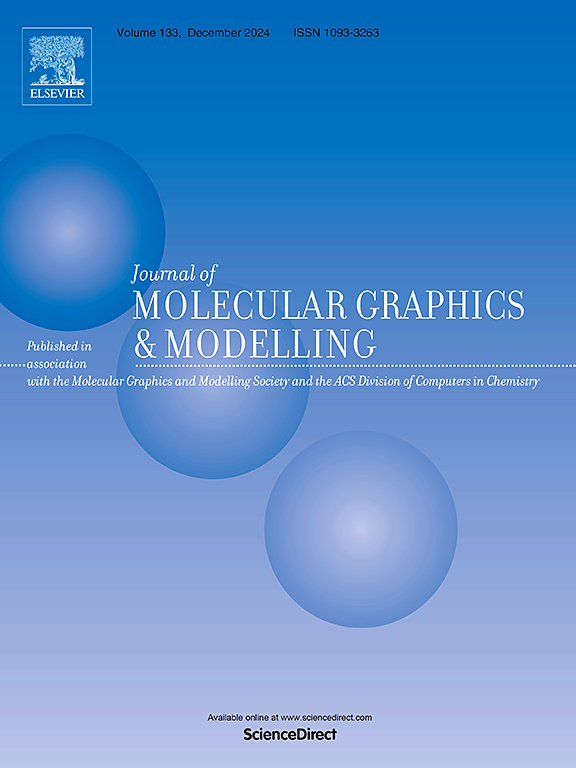Molecular networks via reduced reverse degree approach
IF 2.7
4区 生物学
Q2 BIOCHEMICAL RESEARCH METHODS
引用次数: 0
Abstract
Porphyrazine and tetrakis porphyrazine are examples of organic compounds with complicated structures of rings. Physicists and chemical researchers have been interested in these structures because of their highly conjugated systems, which lead to peculiar optical and electrical characteristics. These structures are the fundamental components of molecular electronics, sensors, functional materials, and catalysis, among other scientific fields. The idea behind modeling molecules as networks is to calculate the topological index, where atoms are nodes and bonds are links. We can use multiple techniques and algorithms to calculate the topological index. We have used the reduced reverse degree-based approach for estimating the topological indices of the Porphyrazine and Tetrakis porphyrazine structures. The purpose of calculating the reduced reverse degree-based topological indices is to quantify the molecular topology of the mentioned structures. In future research, we can also use these indices in SAR/QSAR modeling of porphyrazine and tetrakis porphyrazine. These indices can also provide comparative analysis and descriptors for predicting chemical behavior, which is useful in material science applications and drug designs. In this study, we present a formula for calculating reduced reverse degree-based topological indices for porphyrazine and tetrakis porphyrazine, including the reduced reverse geometric arithmetic index, reduced reverse general Randić index, reduced reverse Balaban index, reduced reverse redefined Zagreb index, reduced reverse forgotten index, reduced reverse hyper-Zagreb index, and reduced reverse atom-bond connectivity index. Before the conclusion, there is a graph-theoretical analysis and comparison to ascertain the essential significance and validate the obtained results. This research helps to create novel materials for a variety of applications and sheds light on the structural and chemical characteristics of these molecular networks.

分子网络的还原逆度方法。
卟啉嗪和四系卟啉嗪是具有复杂环结构的有机化合物。物理学家和化学研究人员一直对这些结构感兴趣,因为它们的高度共轭系统导致了特殊的光学和电学特性。这些结构是分子电子学、传感器、功能材料和催化等科学领域的基本组成部分。将分子建模为网络的想法是计算拓扑指数,其中原子是节点,键是链接。我们可以使用多种技术和算法来计算拓扑索引。我们已经使用了减少的反向度为基础的方法来估计卟啉和四联卟啉结构的拓扑指数。计算基于逆度的简化拓扑指数的目的是量化上述结构的分子拓扑结构。在未来的研究中,我们还可以将这些指标用于卟啉和四系卟啉的SAR/QSAR建模。这些指标还可以为预测化学行为提供比较分析和描述符,在材料科学应用和药物设计中很有用。在这项研究中,我们提出了一个计算卟啉和四系卟啉的简化反向度拓扑指数的公式,包括简化的反向几何算术指数、简化的反向一般randovic指数、简化的反向Balaban指数、简化的反向重定义萨格勒布指数、简化的反向遗忘指数、简化的反向超萨格勒布指数和简化的反向原子键连通性指数。在得出结论之前,进行了图论分析和比较,以确定研究的本质意义,并验证所得结果。这项研究有助于为各种应用创造新的材料,并揭示了这些分子网络的结构和化学特性。
本文章由计算机程序翻译,如有差异,请以英文原文为准。
求助全文
约1分钟内获得全文
求助全文
来源期刊

Journal of molecular graphics & modelling
生物-计算机:跨学科应用
CiteScore
5.50
自引率
6.90%
发文量
216
审稿时长
35 days
期刊介绍:
The Journal of Molecular Graphics and Modelling is devoted to the publication of papers on the uses of computers in theoretical investigations of molecular structure, function, interaction, and design. The scope of the journal includes all aspects of molecular modeling and computational chemistry, including, for instance, the study of molecular shape and properties, molecular simulations, protein and polymer engineering, drug design, materials design, structure-activity and structure-property relationships, database mining, and compound library design.
As a primary research journal, JMGM seeks to bring new knowledge to the attention of our readers. As such, submissions to the journal need to not only report results, but must draw conclusions and explore implications of the work presented. Authors are strongly encouraged to bear this in mind when preparing manuscripts. Routine applications of standard modelling approaches, providing only very limited new scientific insight, will not meet our criteria for publication. Reproducibility of reported calculations is an important issue. Wherever possible, we urge authors to enhance their papers with Supplementary Data, for example, in QSAR studies machine-readable versions of molecular datasets or in the development of new force-field parameters versions of the topology and force field parameter files. Routine applications of existing methods that do not lead to genuinely new insight will not be considered.
 求助内容:
求助内容: 应助结果提醒方式:
应助结果提醒方式:


